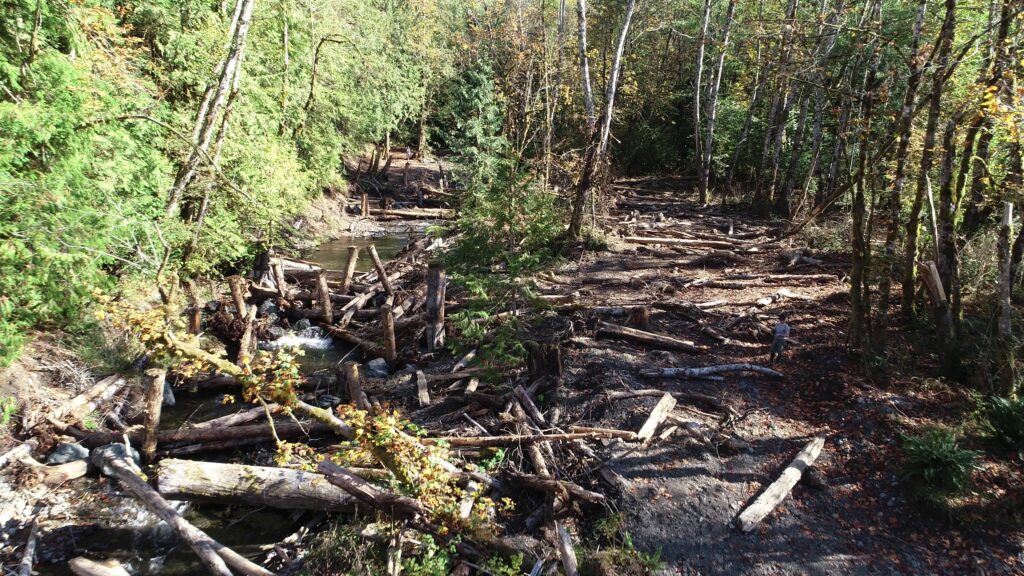
The Lower Elwha Klallam Tribe conducts habitat restoration projects in multiple watersheds along the north Olympic Peninsula. The projects are identified through habitat monitoring programs (See Fisheries and Wildlife pages) and watershed analysis. Once identified, the Tribe seeks grant funding to construct the projects. The tribe has an award winning restoration crew consisting of both tribal and non-tribal members experienced with heavy equipment. The Tribe has completed 75 different projects since 1994 with a total value of 30 million dollars. Projects have been constructed in the Hoko, Morse Creek, Elwha, Ennis, Pysht, Little River, East Twin, and Deep Creek. Project types include additions of wood to stream channels (engineered log jams), barrier corrections, floodplain revegetation, invasive species removal, and road abandonment.
In addition, The Tribe and other partners have carried out multiple shoreline restoration projects along the interior of Ediz Hook, the spit that created and shelters Port Angeles harbor. Over a mile of shoreline habitat along the interior of Ediz Hook have been restored, including a PA Harbor Clean-up project to remove former log rafting and offloading structures and associated shoreline armoring and replacement with clean beach material. Native beach and nearshore vegetation have also been planted to restore shoreline habitat.
An Engineered log jam (ELJ) is a “human designed and constructed log structure that emulates the functions of historic naturally-occurring logjams to restore riverine geomorphic, hydraulic, and sediment transport processes” (Abbe et al 2018). After ELJ construction, native vegetation is planted and the end product mimics a naturally occurring structure in the river. Log jams create pools, slow high flow waters, hold back fine sediments, reduce riverbed incision, and create spawning and rearing habitat. Pools are useful as resting areas for juvenile and returning adult salmonids, and are a cool water refuge during summer low flows. Retaining fine sediments behind a log jam can raise a riverbed to reduce incision, and retain gravels that salmon and trout use to spawn. Native vegetation is important in riparian restoration because it offers rivers shade/ temperature-control, structure/erosion-control, terrestrial insect presence, detritus for aquatic insect sustenance, and woody debris to aid in river structure-meander and pools. ELJs have been critical to recent restoration efforts on the Elwha River, Little River, Indian Creek and Pysht River.
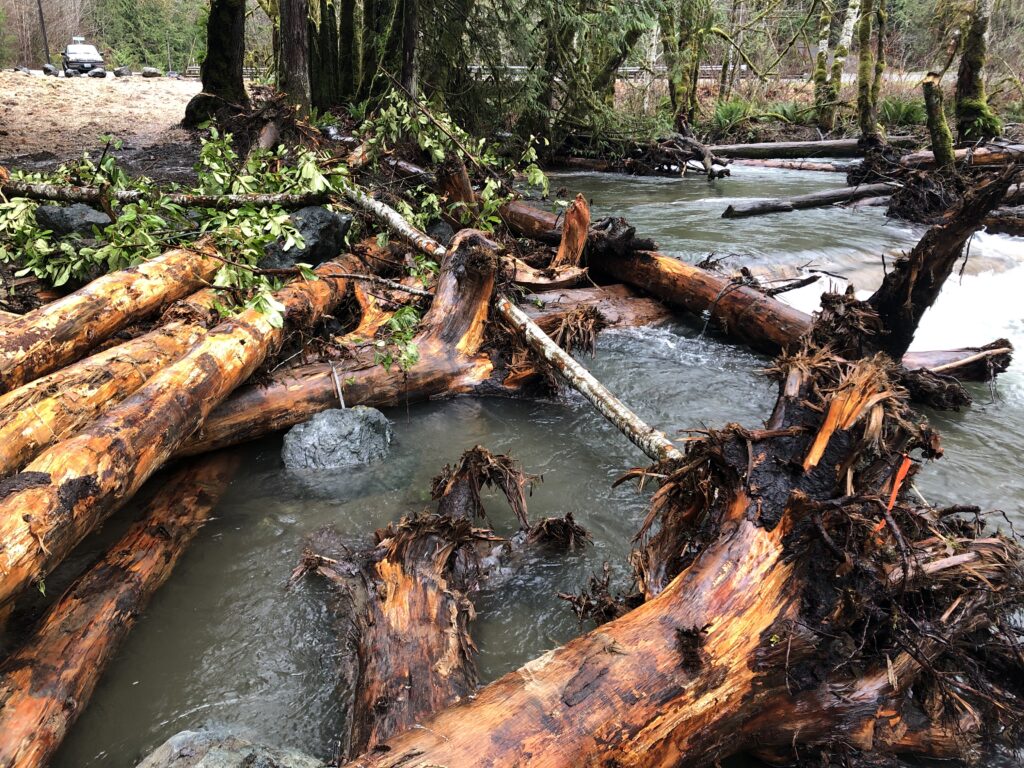
To learn more about the benefits of ELJs, check out:
In addition to ELJs, habitat restoration work often necessitates identifying and addressing specific sites impacted by historic land uses. The correction of human caused barriers is a crucial first step in conducting habitat restoration for Pacific salmon. These include dams and culverts, which prevent upstream migration, but also dikes which disconnect rivers laterally from their floodplains. Probably the most widespread of barriers are those created when roads where built across rivers and creeks and those creeks where confined to culverts. Historically those culverts were undersized and over time created barriers and stream channels were eroded downstream of the culvert outlet. It is estimated that thousands of barrier culverts are affecting Pacific salmon across Washington State.
LEKT has been active correcting these barriers with completed projects in the Pysht River, Salt Creek, Indian Creek and the Elwha River. For example, at Indian Creek, the Tribe removed a 700’ long dike likely constructed to divert water away from the highway, which restored connectivity to the creek’s historic floodplain and had immediate benefits for fish habitat. Chinook salmon were observed spawning in the reach while the project was being completed.
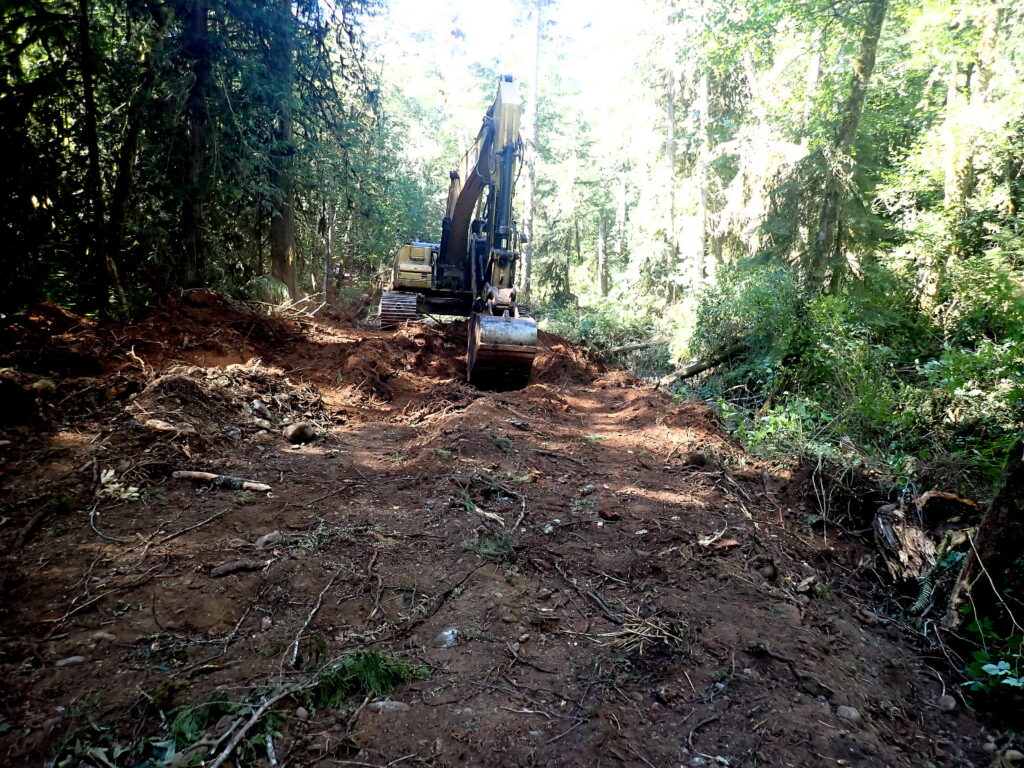
Once barrier corrections have been made and/or other restoration phases such as installing ELJs have been completed, the next stage of restoration is to revegetate disturbed areas in the watershed. The goals of LEKT revegetation programs are to accelerate the establishment of native forests, restore ecosystem processes, and protect diverse native plant communities to better provide a resource for Elwha people to gather traditional plant medicine, food and plant products, as well as enhance the ecosystem by maintaining healthy thriving habitat for fish and wildlife. These efforts also aim to continue to increase native woody forests and build climate change resiliency by planting conifers (See Climate Change page for more information and link to vulnerability assessment).
Of particular emphasis is the restoration of the Elwha River ecosystem, where LEKT has been a partner in a massive revegetation effort that followed the removal of the two former dams. LEKT staff along with Olympic National Park, Washington Conservation Corps, and volunteers planted nearly 800 acres of dewatered lands in the former Aldwell and Mills reservoirs on the Elwha River. To date there have been 425,000 rooted plants planted, 7,200 lbs of seed, and live stakes planted here. The majority of the plants grown for this project were propagated from seed collected from the Elwha watershed. All plants grown for the project are native to the local area. Species includes a mix of conifers, deciduous trees, shrubs, forbes, and grasses. Many of the plants grown for the project are of cultural significance such as Western Red Cedar, Red Huckleberry, Salmonberry, and Salal (among many others). Most plants have been grown out at a local Olympic National Park nursery in Sequim; the Matt Albright Nursery, that was first founded to serve the grand scale of the Elwha revegetation project. LEKT staff are still planting the former reservoirs to date, along with conducting other revegetation restoration projects in the LEKT U&A (usual and accustomed hunting and fishing areas).
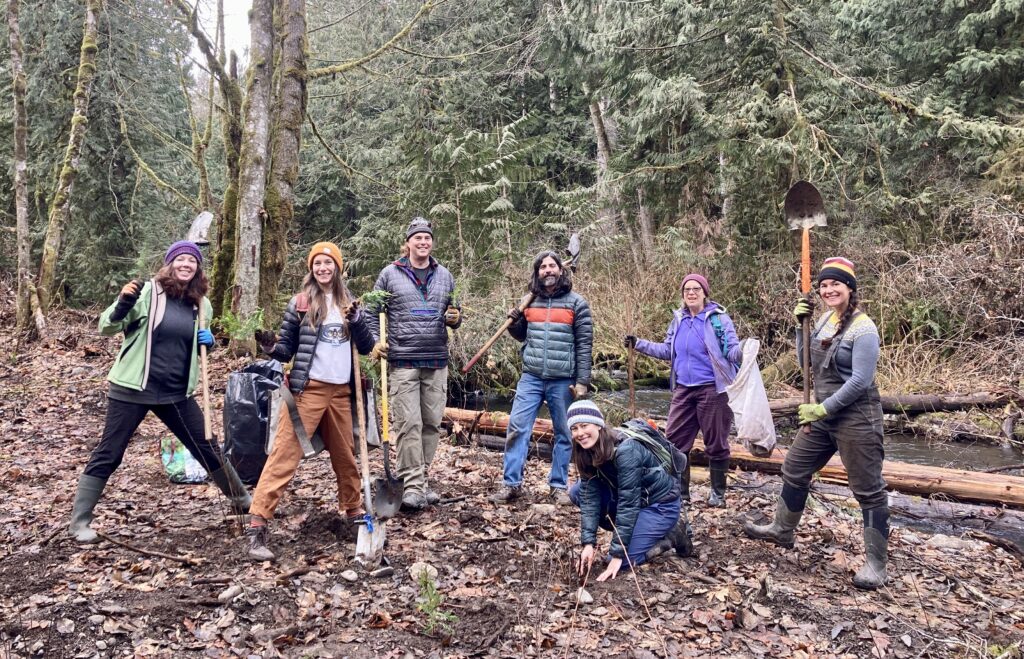
A crucial component of restoration work also includes the removal of invasive plant species via spraying, cutting, and manually pulling. When using chemical control, LEKT uses aquatic-safe herbicide when appropriate and maintains licenses and permits issued by the Department of Ecology and the Department of Agriculture. Invasive species are invasive because of how quickly they can grow and spread. They are listed species by the state of Washington in a ranking of most important to control to least important to control and LEKT revegetation follows these guidelines. It is important to control these noxious weeds and attempt to prevent/remove seeds before they spread. These species become invasive because of pressures on the ecosystem, which can create a lack of herbivores, pests, and diseases that would otherwise keep them in check in a healthy native ecosystem. Noxious weeds can be allelopathic, which means they prevent other plant species from germinating and growing near them by producing their own chemical inhibitors, or even their own herbicide. They can also dominate native species habitat due to their proficiency at seed production and rapid growth rates. Invasive species control goes hand-in-hand with revegetation of native species.
Port Angeles Harbor is the largest natural deep water harbor on the west coast of the United States. It was created during the Holocene when feeder bluffs within the Elwha River drift cell to the west formed the long, protective eastward projecting sand spit (Ediz Hook). Port Angeles Harbor has a long, rich history of cultural importance to the Klallam people. Three Klallam village sites were along the southern shoreline of the harbor, including Tse-Whit-Zen (western harbor) and Y’innis (Ennis Creek, eastern harbor), the former dating at least 2,500 years ago.
The 1,325-acre harbor is a typical Northwest “working harbor” with uses that include industrial, commercial, municipal, marine trades, recreation, tourism and natural resources. More than a century of industrial activities has exacted a heavy toll on natural systems within the harbor due to contaminants, extensive shoreline armoring, and in-water structures. This has resulted in contamination of sediments, fish and shellfish, heavily degraded shorelines, and loss of critical nearshore and estuarine habitat used by salmon and their forage fish prey. In addition, the damming of the Elwha River in 1912, coupled with armoring of the feeder bluffs, reduced the sediment supply to Ediz Hook by 88%, resulting in outer shoreline erosion and overtopping by waves. The US Army Corps of Engineers responded with extensive armoring of the outer Ediz Hook shoreline in the 1970s, which continues with periodic augmentation today.
After the closure of the ITT Rayonier Paper Mill in 1997, the Environmental Protection Agency completed an Expanded Site Investigation of the Harbor and concluded that the Harbor was eligible for listing under the Superfund Law (CERCLA 1980). The State and City of Port Angeles petitioned for the Deferral of the cleanup under State (Ecology) leadership. The Tribe became actively involved in the oversight of the cleanup of Port Angeles Harbor in 1999, when the Tribe entered into a 3-party Deferral Agreement (2000) with EPA and the Department of Ecology. This unique oversight role gives the Tribe concurrence on all major cleanup decisions at this site. Since that time, the Tribe also became engaged in the Western Harbor Cleanup. This cleanup, also led by Ecology, involves 6 Potentially Liable Parties (PLPs)- Port of Port Angeles, City of Port Angeles, Nippon Paper, Georgia Pacific, Merrill and Ring, and Owens Corning. Additional restoration of approximately 120 meters of shoreline occurred in 2022-2023 when the former Cooke Aquaculture laydown site, a large artificial fill structure on the eastern end of Ediz Hook, was removed and the associated shoreline restored.
Click here for more information about this collaborative effort: https://www.peninsuladailynews.com/news/lower-elwha-restoration-project-in-progress/
Eelgrass beds provide critical nursery habitat for juvenile salmon and forage fish and habitat for a wide diversity of other fish and invertebrates. Eelgrass habitat has been on the decline throughout Puget Sound and the Salish Sea due to shoreline development activities, rock armoring, and other anthropogenic factors. In May 2022, Governor Inslee signed the Kelp Forest and Eelgrass Meadow Conservation Initiative (Sen. Bill 5619) to conserve and restore eelgrass systems throughout Puget Sound.
In 2017 the Tribe and its partner, Pacific Northwest National Lab (PNNL), conducted an eelgrass salvage effort to remove eelgrass from under the US Navy’s newly installed Transit Protection System Pier to save the plants from extirpation due to the effects of shading and prop wash. Some 7,000 eelgrass plants were salvaged, half of which were planted by a dive team comprised of PNNL, LEKT, SeaGrant, and local divers. The remaining plants were planted in outdoor tanks at the PNNL facility. This “seed” population has resulted in the production of eelgrass plants to support subsequent plantings every year since, with the exception of 2022.
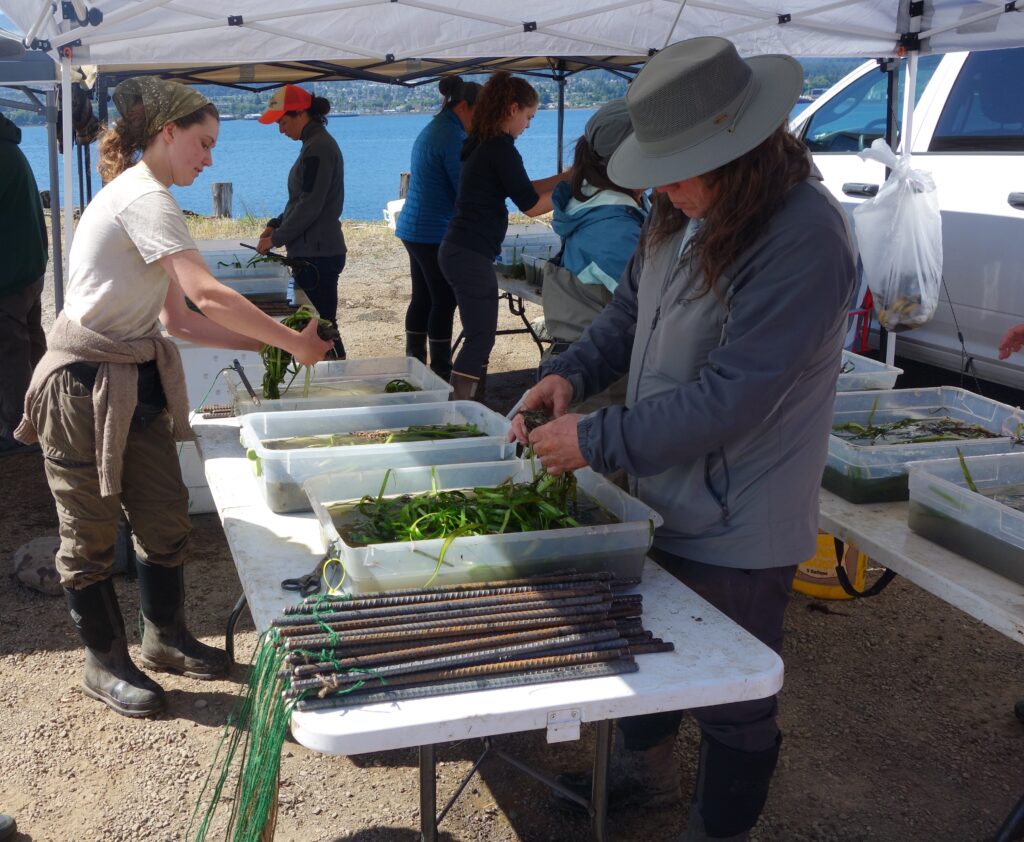
A total of 20,000 eelgrass plants have been planted along the Ediz Hook shoreline, adjacent to the shoreline restoration projects completed by the Tribe’s restoration crew. New eelgrass meadows have recently been identified in the vicinity that are likely derived from previous nearby plantings and likely seeded on the new habitat created from fine sediment eroding from the newly restored beaches. This is an example of a positive synergistic relationship between two, otherwise separate, restoration projects.
Want to get involved in Habitat Restoration efforts!? Visit our News & Outreach page for upcoming opportunities to volunteer in currently active projects.
